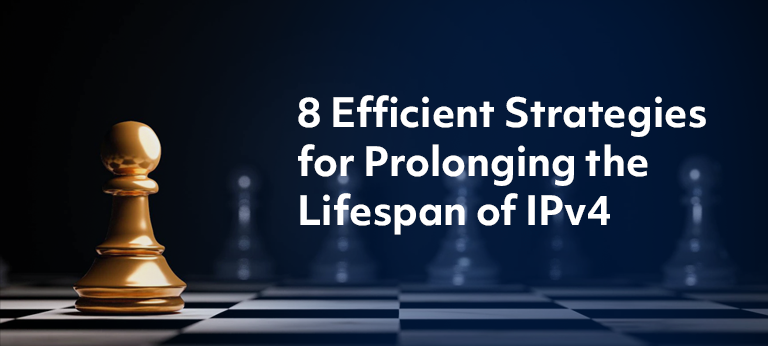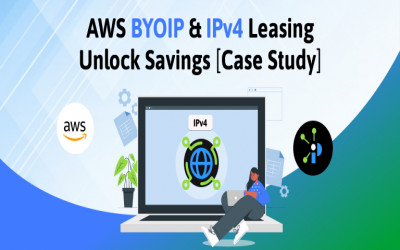8 Efficient Strategies for Prolonging the Lifespan of IPv4
-
Posted at 2022-09-20 14:37:57

The end of IPv4 has been predicted by IPv6 proponents for some time. While IPv4 addresses have already been exhausted, many organizations are ambiguous about what to do next. While moving to IPv6 is needed, prolonging the lifespan of IPv4 is also important.
We will shortly have 7 billion people in the world, but only 4.2 billion IPv4 addresses. John Curran, the President and CEO of American Registry of Internet Numbers (ARIN) gave a presentation recently where he dealt with the vital issue of IPv4 number exhaustion.
From the presentation, it is evident that it is a matter of time before the world completely runs out of public IPv4 addresses. This is going to act as an obstacle for innovation. There are issues related to adopting IPv6 on a large scale basis. As a result, the only solution is to work out strategies to prolong the lifespan of IPv4. Here are 8 such strategies.
1) Increase the efficiency of IPv4 addresses
Using IPv4 addresses efficiently is vital. IP address reclamation projects are on to find unused IPv4 address blocks and repurpose them. Rearranging the use of IPv4 public addresses is also needed. However, these are short-term measures. While they can help for the present, for the long-term we need to prepare to deploy IPv6. Organizations will be managing both IPv4 and IPv6 together and so increase IPv4 efficiency is a must.
2) CGN, LSN, and NAT 444
Performing multiple layers of NAT (network addresses translation) or PAT (port addresses translation) can help prolong the lifespan of IPv4. It is called a NAT 444 technique because two levels of NAT/PAT are performed. If the performance of the Carrier Grade NAT (CGN) and Large scale NAT (LSN) is limited, there could be connectivity issues. This is thus not an optimal solution but is a strategy to prolong IPv4 lifespan.
3) Protocol Translation
Using IPv4 inside your organization and translating the addresses to IPv6 is a strategy that can be considered. There are enough RFC 1918 private IPv4 addresses for internal networks. A system is needed for the protocol translation. This is not an ideal solution since there could be problems for many applications. It is only a last resort measure as an IPv6 transition method.
4) DS-Lite
Dual Stack Lite of DS-Lite is an IPv6 transition mechanism that can be implemented within the service provider’s infrastructure. It encapsulates the IPv4 packets of the end-user inside IPv6 packets. It is a tunneling technique that improves on multiple NAT layers. This allows the subscriber CPE devices to use the same IPv4 address space, but their packet would be identified uniquely using the IPv6 encapsulation. It requires the core ISP network to be IPv6 enabled, which is not the case with many operators.
5) Address Plus Port
AP or Address Plus Port is an address sharing technique that borrows bits from the port number and makes use of them to augment the IPv4 address. It helps to yield more public IPv4 addresses. It allows multiple hosts to share one public IPv4 address with a port range for its applications. While it avoids problems of centralized CGN/LSN, it works only for those applications using TCP/UDP numbers.
6) IPv4 Address Sharing
This strategy involves devices having an IPv4 address only when it is on the internet. At other times, the address is released for use by other devices. It would be suitable for mobile devices where IP address is not needed when the user is asleep. The strategy can work provided the temporary leasing of the address happens quickly.
7) LISP
Locator ID Separation Protocol or LISP is a network architecture protocol, which separates the namespace into two parts. The first is the Routing Locator used for the routing, and the second the Endpoint Identifier used for the end-node. It is a tunneling technique that adds a 32 byte UDP port 4341 LISP address. Its benefit is vendors like Cisco and Facebook support its use.
8) HIP
Host Identity Protocol is a ‘two space technique’ that inserts a shim between the IP header and the transport header, which have the host identifier and location. It calls for modifying the IP stack in the OS and changes to DNS. It also calls for a global PKI since it uses cryptographic keys.
Each of these strategies have their own challenges for implementation. Whether these technologies are good ideas or not, it will take a long time for these solutions to be implemented. CGN/LSN technology is necessary for reliable supply and distribution service providers. The IP stack shim technology requires software to be integrated into all operating systems and network devices used by many manufacturers in an interoperable manner. Just look at how much time it has taken to get IPv6 capabilities into the broad range of systems available today. Even if someone has a good idea today, it will be years before ubiquitous distribution in the Internet world is possible. If you think the Internet is in bad shape now, we just can't wait 5-10 years from now for the hot-new-idea to be ready for deployment.


.png)
